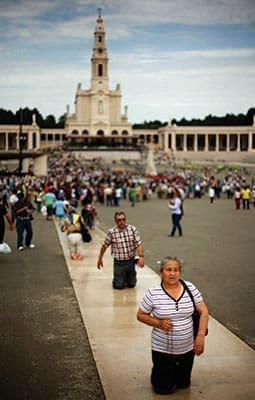 CNS photo/Nacho Doce, Reuters
CNS photo/Nacho Doce, ReutersAtlanta
Pilgrims To Fatima Include Many Devoted Popes
By GRETCHEN KEISER, Staff Writer | Published May 9, 2013
ATLANTA—Pope Francis, in asking that his papacy be consecrated to Our Lady of Fatima, continues the close interrelationship between popes and this 20th-century apparition of Mary.
On May 13, 2013, the bishops of Portugal are expected to pray on Pope Francis’ behalf this prayer of consecration, as he has asked them to do.
Fatima, located in Portugal, is where three shepherd children had a series of reported apparitions of the Blessed Mother in 1917, beginning on May 13 and ending on Oct. 13 of that year.
During these visits, the children said Mary asked for people to pray the rosary daily, for peace in the world and for personal conversion, and, in particular, to pray the rosary, and participate in the Eucharist and confession on the first Saturdays of the month, as a prayer of reparation to the hearts of Jesus and Mary. She also asked for the consecration of Russia to her Immaculate Heart.
The last of the visions, on Oct. 13, 1917, attracted 70,000 people who witnessed what has been called “the miracle of the sun.”
Two of the children, Jacinta and Francisco, died a few years later during the flu pandemic. The third visionary, Sister Lucia, lived her life as a cloistered Carmelite nun and died in 2005.
In 1930, local Catholic officials concluded a lengthy study of the events and determined that the apparitions are worthy of belief. Fatima has become one of the most popular Marian pilgrimage sites with more than 1 million visitors each year.
In the 96 years since the apparitions, popes of the 20th and 21st centuries have spoken and acted in response to the call for the rosary, penance and entrustment to Mary’s Immaculate Heart.
Jacinta and Francisco Marto were beatified in the year 2000 by Pope John Paul II, who also asked that a message of Fatima confided only to the pope, be published.
Pope Emeritus Benedict XVI, who helped explain the third secret of Fatima when it was published in 2000, said in 2010 that the messages extend in time to apply to the church’s continuing journey, which is accompanied by suffering.
While traveling to the Marian shrine of Fatima in May 2010, Pope Benedict said that the priestly sex abuse scandal is a crisis that comes from inside the church—not from an outside attack—and requires purification and penance to overcome.
The vision of Fatima foresaw the need for the church to undergo a “passion,” which continues in various ways until the end of time, and which requires a response of continual conversion, he said.

Pilgrims walk on their knees at the Marian shrine of Fatima in central Portugal May 12, 2012. Thousands of pilgrims arrived at the shrine to attend the 95th anniversary of the first apparition of Mary to three shepherd children. Lucia dos Santos and her cousins, Francisco and Jacinta Marto, received the first of several visions of Mary May 13, 1917.
“Among the new things that we can discover today in this message is that attacks on the pope and the church come not only from the outside, but the suffering of the church comes from inside the church, from sins that exist inside the church,” he said.
“We have to relearn these essentials: conversion, prayer, penance,” he said.
On the 25th anniversary of the apparitions in 1942, Pope Pius XII consecrated the Church and the human race to the Immaculate Heart of Mary, and in 1944 he extended the feast of the Immaculate Heart of Mary to the entire Church.
On the 50th anniversary, in 1967, Pope Paul VI made a pilgrimage to Fatima and released “The Great Sign,” an apostolic exhortation on devotion to Mary, inviting individuals to entrust themselves to Mary’s Immaculate Heart and let this “pious act” lead to “concrete action in their daily lives.”
On March 25, 1984, Pope John Paul II in union with all the bishops of the world consecrated all peoples to the Immaculate Heart of Mary.
Blessed Pope John Paul II had a special devotion to Our Lady of Fatima and credited her with saving his life, when he was shot and critically wounded.
He said the assassination attempt against him, which took place on May 13, 1981, in St. Peter’s Square, did not take his life because of her intervention. He made pilgrimages to Fatima in 1982 and 10 years after the assassination attempt in 1991 specifically to express his gratitude for the Blessed Mother’s aid. He gave the bullet that struck him to the Marian shrine. It has been placed in the crown of the statue of Our Lady of Fatima.
In a message to the bishops of Italy in 1994, Pope John Paul II said, `”It was a maternal hand that guided the path of the bullet, and the pope, in agony, was transported to the Gemelli hospital, pausing on the threshold of death.’’
“That shot in St. Peter’s Square should have taken the life of the pope 13 years ago,’’ he said. “But instead, the mortal bullet was stopped and the pope lives—lives to serve.’’
In 1991, the Polish pontiff also thanked her for helping to free Eastern Europe from communism. But he added that the message of Mary is an ongoing one of deepening individual faith.
The need to strengthen spiritual life is what still draws people to Fatima, he said.
“This enormous multitude of pilgrims with candles of faith lit and the rosary in their hands confirms that I have reached Fatima,’’ he said in 1991, addressing more than 500,000 people gathered at the Marian shrine.
Speaking of the commentary he wrote on the Fatima secret, Pope Benedict said that for him it can be summarized “by the consoling promise of the Most Holy Virgin: ‘My immaculate heart will triumph.’”